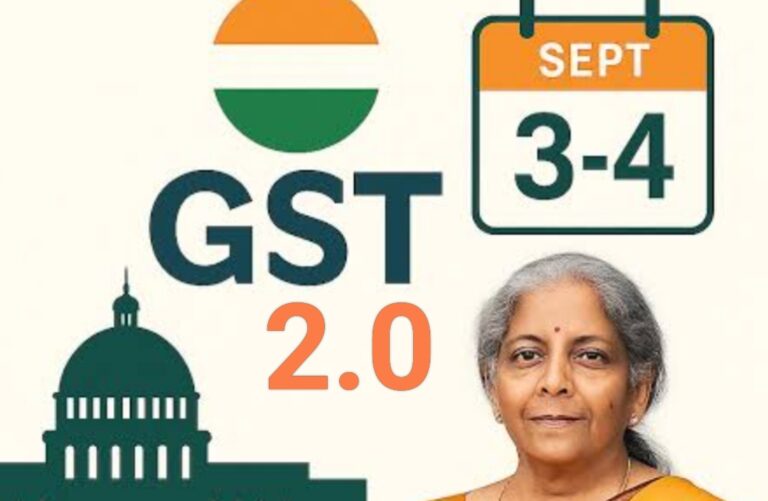The Goods and Services Tax (GST), launched in July 2017, has been one of the most transformative tax reforms in India’s history. Now, eight years later, the indirect tax regime is at a critical crossroads. The 56th GST Council Meeting, scheduled for 3rd and 4th September 2025 in New Delhi, is being hailed as a landmark session with the potential to shape the next phase of India’s tax journey.
The anticipation is heightened by the Hon’ble Prime Minister’s Independence Day address on 15th August 2025, where he highlighted “next-generation GST reforms” as a possible festive season relief for citizens and businesses. Discussions are expected to cover GST rate rationalisation, insurance premium taxation, the future of compensation cess, and compliance simplification. While proposals are ambitious, the final decisions will only be known after the Union Finance Minister’s official press briefing post-meeting.
GST Rate Rationalisation: Moving Towards a Simplified Structure
One of the most debated issues since GST’s introduction has been its multi-slab tax structure. Currently, GST is levied at 5%, 12%, 18%, and 28%, along with an additional compensation cess on certain products. This complex framework has often led to classification disputes, inverted duty issues, and litigation.
The proposal under consideration aims to simplify GST into a two-tier structure:
- 5% for essential goods and services.
- 18% as the standard rate for most categories.
- A higher slab around 40% for ultra-luxury and sin goods, effectively replacing the existing compensation cess.
If implemented, several goods under the 12% bracket could shift to 5%, while many currently taxed at 28% may move to 18%.
Impact on stakeholders:
- Consumers could benefit from lower prices on essentials, household appliances, and even small cars.
- Industries may witness reduced litigation and greater clarity.
- States may raise concerns over revenue loss, making fiscal compensation discussions crucial.
Insurance Premiums: Possible Relief on GST
Another major reform on the agenda is the removal of GST on life and health insurance premiums. At present, individuals pay 18% GST on such policies, significantly increasing the cost of coverage.
The proposal seeks to place these services in the GST-exempt category, thereby reducing premium costs and encouraging wider insurance adoption.
Expected benefits:
- More affordable coverage for households.
- Better alignment with the government’s social security and financial inclusion goals.
- Higher penetration of life and health insurance in India.
However, two challenges remain: ensuring insurers pass on the benefit directly to policyholders and addressing the potential revenue loss for states.
Compensation Cess: Entering the Final Phase
The compensation cess, introduced in 2017 to safeguard states against GST-related revenue losses, was initially planned for five years but extended to service borrowings during the pandemic. Currently, it applies to products like luxury cars, tobacco, and aerated drinks.
At the 56th Council meeting, discussions are likely to focus on its future:
- One option is to end the cess by early 2026 or advance the timeline.
- Another approach is to merge it into the proposed 40% slab for luxury and demerit goods.
While this move could simplify the structure, states worry about losing a dedicated revenue stream. The Centre, on the other hand, expects higher consumption from lower tax rates to offset losses.
GST 2.0: Simplifying Compliance & Ease of Doing Business
Beyond tax rates, GST 2.0 aims to make compliance more seamless and digital-friendly. Key reforms under discussion include:
- Pre-filled GST returns to minimize data entry and reconciliation.
- Automated refund systems, especially for exporters, to improve cash flow.
- Correction of inverted duty structures in sectors like textiles, fertilizers, and footwear.
- Enhanced technology-driven monitoring for higher compliance with reduced intervention.
These steps are expected to boost the ease of doing business, reduce litigation, and provide a more predictable tax environment.
Road Ahead: Balancing Reforms with Revenue Stability
The 56th GST Council Meeting carries high expectations from businesses, taxpayers, and consumers. With proposals for lower tax rates, insurance relief, and simpler compliance, the reforms promise affordability and growth. However, since the Council operates on consensus, the final outcome will depend on states’ fiscal considerations and negotiation with the Centre.
Once deliberations conclude, the Union Finance Minister will announce the official decisions and timelines. Until then, all proposals remain under discussion.
Conclusion
As India gears up for the festive season, the possibility of lower taxes on essentials, GST exemption on insurance premiums, and simplified compliance has generated widespread optimism. While businesses expect fewer compliance hurdles, citizens look forward to reduced costs, and states seek reassurance on revenue protection.
If consensus is reached, the 56th GST Council Meeting could mark the beginning of a streamlined, equitable, and growth-oriented tax framework—truly the dawn of GST 2.0 in India.
